
|
|
Für die deutsche Fassung bitte nach unten scrollen
|
|
|
|
Happy Holidays –
with Art that is Thousands of Years old
|
You do not have a Holiday gift yet? Take this opportunity and benefit until the end of the year from the reduced value-added tax (VAT) of 5 percent on ancient art. As of 1 January 2022 the VAT will be raised again to 13 percent. By the way: The increase in value for ancient treasures does not solely depend on the tax rate. The auctions of the last weeks have revealed that the demand for millennium old masterworks is higher than ever. One world record price after the other – also for Vinča figures from the now world-famous Jovanovic collection which last auctioned with Christie's in London. We have been curating the Jovanovic collection for several years, and we have now succeeded in acquiring the last Neolithic figures from the estate of Dusan Jovanovic (1956-2015). In this newsletter we present the first five Vinča figures.
|
|
|
|
Our Highlight of the Month:
|
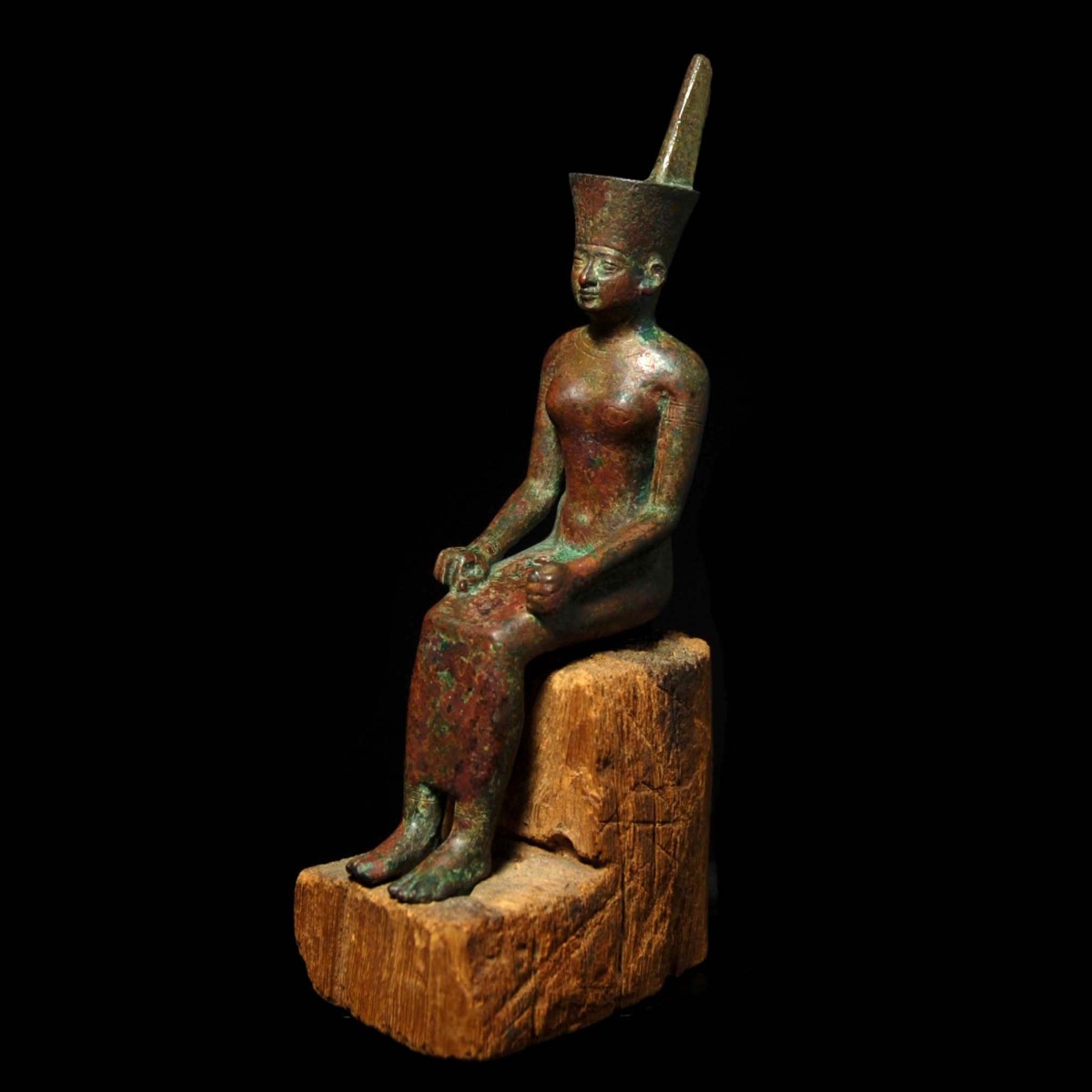
|
|
|
|
|
|
Egypt – 26th dynasty, 664-525 B.C.
|
Very finely worked out and graceful seated statuette of goddess Neith, the main and tutelary deity of Sais. Neith wears the crown of Lower Egypt, which is finely decorated in cold work. Her form fitting gown accentuates her large, round breasts and small hip – a depiction which is typical for the 26th dynasty. She places her clenched fists on her lap, one fist raised, the other one open. The round face with fine features, the mouth is formed to a smile. She wears a multiple-row jewellery around her neck. The statuette sits on an ancient wood base, which possibly is belonging. With a wonderful red-brownish patina. Neith was the goddess of hunting and of war. In the 26th dynasty, the Saite Dynasty, she was considered the highest tutelary deity.
|
Provenance: Acquired in the 1930s in Egypt. Thence as a gift to an English collector. By descent to the collection J. Pearson, England. Last in the English and US art markets.
Dimensions: 16.6 cm high
Price: 24 000 Euro
|
|
|
|
Selected Artworks of the Month:
|
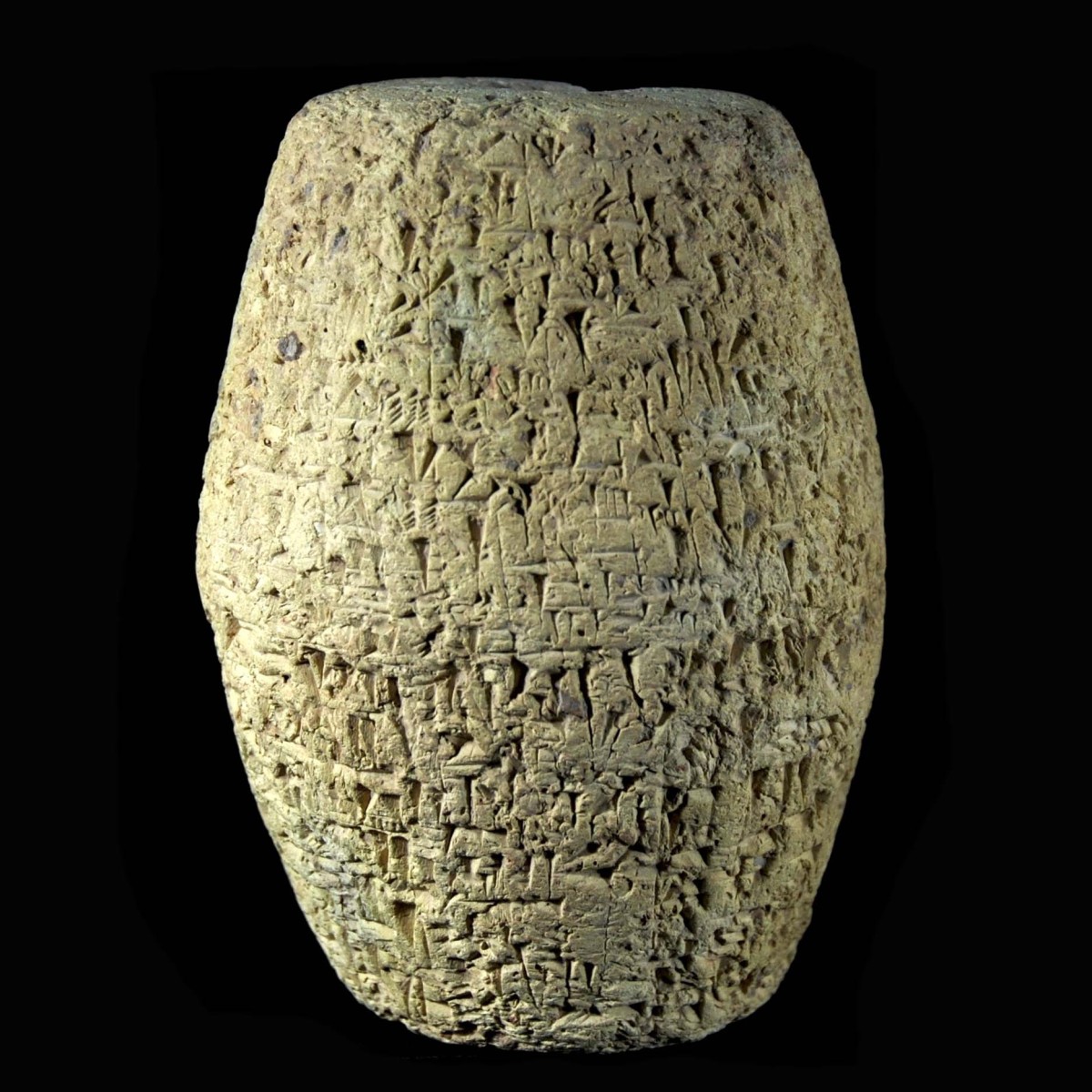
|
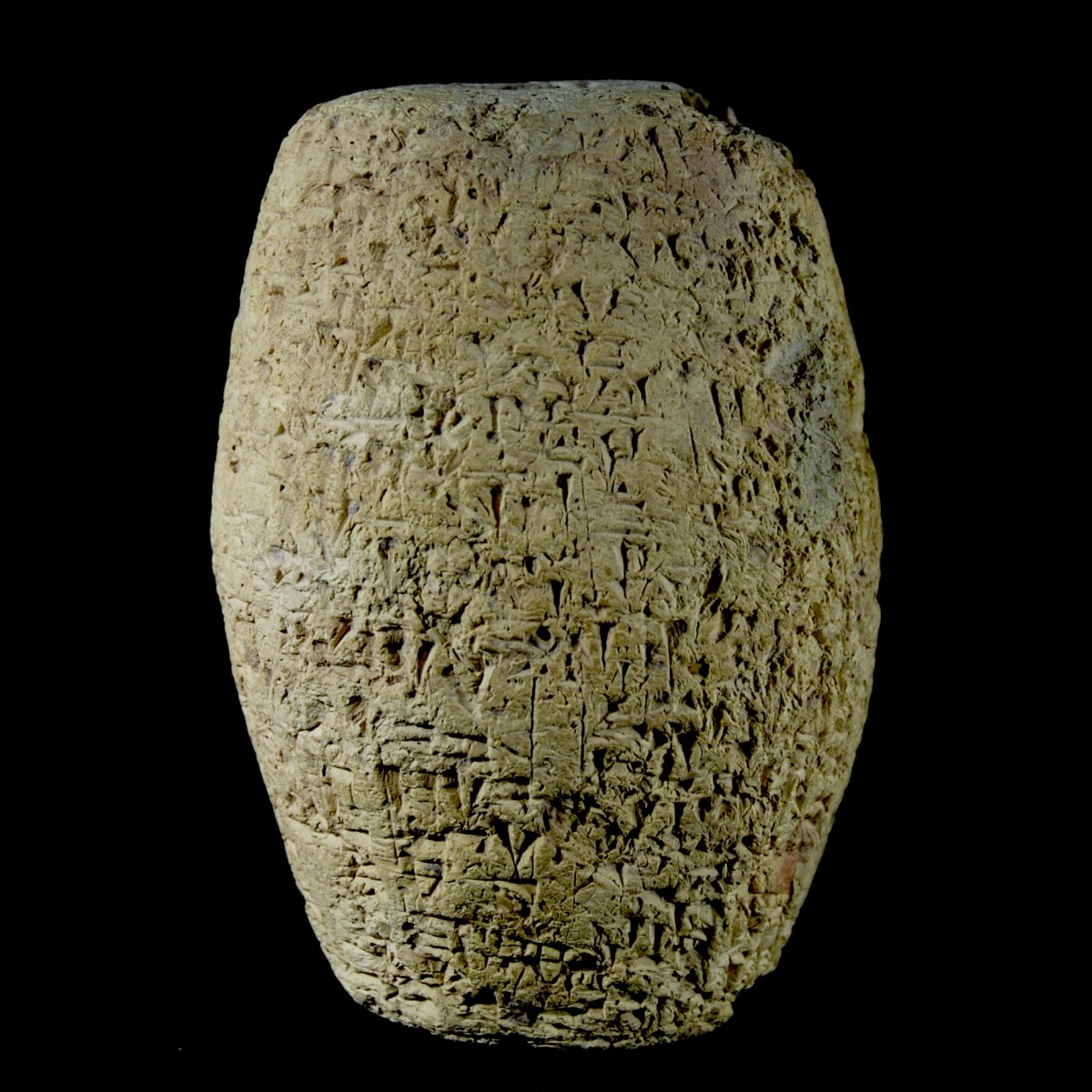
|
|
|
|
Mesopotamia – 1785-1778 B.C.
|
Massive clay barrel from the period of the Old Babylonian king Sin-Iddinam from Larsa. The cuneiform barrel with a flat base and a circular opening on top depicts an inscription of around 70 lines covering the entire outside. Sin-Iddinam stresses that he dredged the river Tigris to provide water supply to his city. A series of similar barrels are known and published. The standard reference originates from Dougals Frayne “The Old Babylonian Period”, 1990, pages 158-160, E4.2.9.2. The translation reads: “I, Sin-Iddinam, mighty man, provider of Ur, king of Larsa, king of the land of Sumer and Akkad, king who built the Ebabbar, temple of the god Utu, who restored the rites of the temples of the gods, when An, Enlil, Nanna and Utu granted to me a good reign of justice whose days are long, by means of my broad wisdom, supremely established, which excels, in order to establish good water for my city (and) land (and) to make magnificent my ways, praise (and) valor for the future, I prayed ardently to the gods An and Enlil. They having agreed to my firm entreaty commissioned (me), by their unalterable word to dig the Tigris, to restore (its banks, and) to establish my name for a long life-span. At that time, by the decree of the gods An and Inanna, by the supreme might of the gods Nanna and (Utu), by means of my triumph I grandly dug there the Tigris, the river of abundance of the god Utu. I connected its intake to the border, the boundary of my choice, and directed its great (course) straight into a swamp (thereby) providing perpetual water, unceasing abundance for Larsa, my land. When I dug the Tigris, the great river, the wages of each worker were: 1 gur of barley, 2 sila of bread, 4 sila of beer, 2 shekels of oil, in one day so they received this. I let nobody take less or more. By the decree (and) decision of the great gods, I restored (the banks) of the Tigris, the broad river, (and) set up my name for the distant future.”
|
Provenance: From an English private collection prior to 1992, thence on the English art market.
Dimensions: 14.5 cm high
Price: 12 000 Euro
|
|
|
|
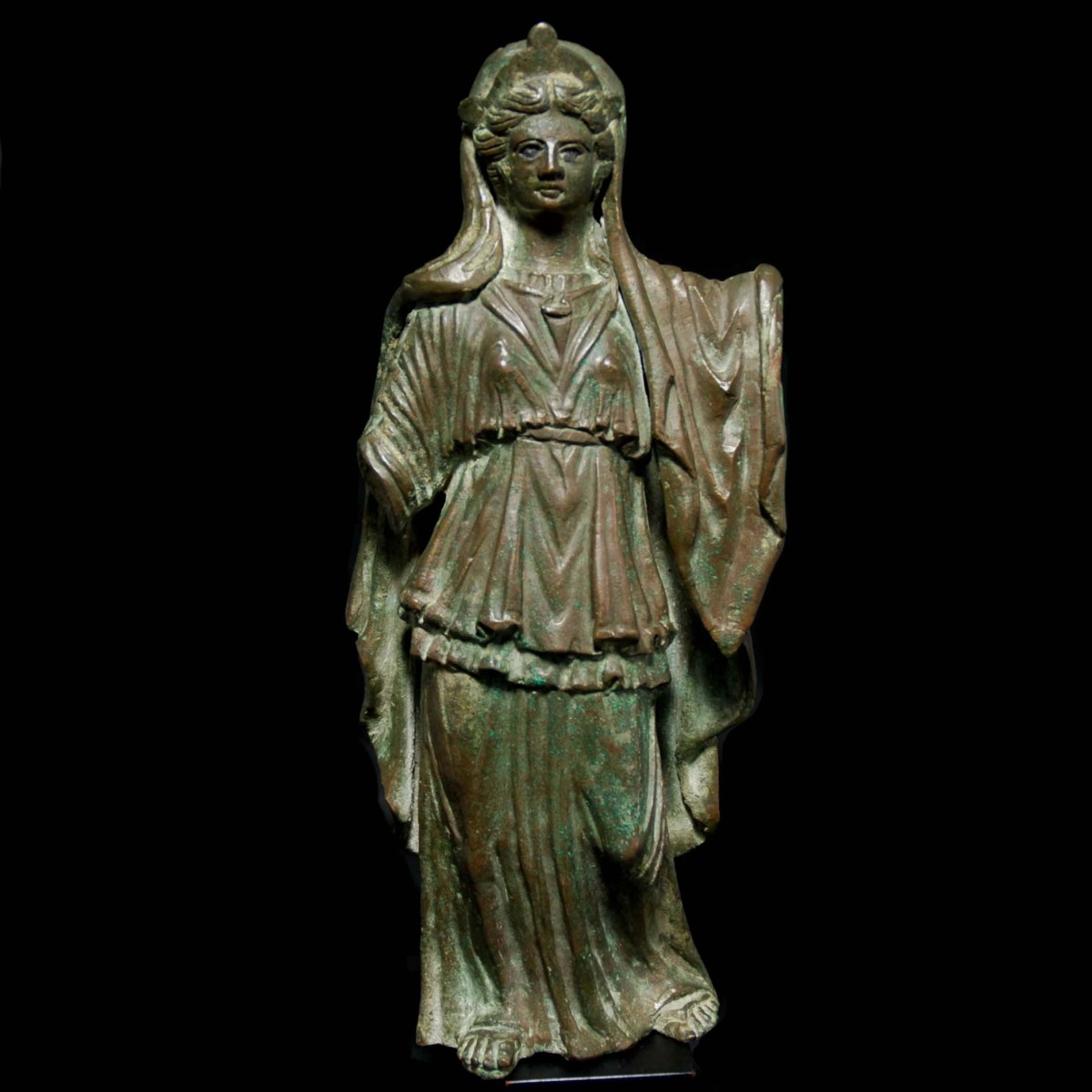
|
|
|
|
|
|
Roman Empire/Gaul – 2nd century A.D.
|
Extraordinarily large bronze statue of Juno worked out from several pieces. The goddess and wife of Jupiter wears a long dress reaching to the floor, with a belt below her breasts. She has a coat over her shoulders, which also covers her head. The end of the coat falls far over the goddess’ left shoulder. The cape is separately cast and attached with a rivet to the actual statue. Juno has her thick hair parted in the centre, held together by a three-rayed diadem. The eyes are with silver inlays. She wears sandals on her feet. The back has the cape with broad pleats. The exceptionally large statue is worked out from several pieces. Apart from the cape also the today missing arms were cast and mounted separately. The slightly provincial style refers to a Gallo-Roman work.
|
Provenance: French private collection. Auctioned with Dorotheum Wien on 28 April 1998, lot 45. Thence private collection Karl Zieger (1939-2021), Lower Austria.
Dimensions: 31.8 cm high
Price: 18 000 Euro
|
|
|
|

|
|
Greece – 3rd-2nd century B.C.
|
Graceful Hellenistic terracotta statuette of a couple lying in bed holding each other tightly. The man rests on his left elbow and embraces with his right arm the woman who lies on top of him. The woman snuggles her cheek on the man’s one, she lies on her belly. The blanket slipped down exposing her back and part of her buttock. Both wear a head cover over the thick, curly hair. The high bed with a headrest and small stairs on the side. With beautiful white, pink and blue color remains. Possibly from Canosa. With an old collection number 10-85 on the base.
|
Provenance: From the private collection of the French archaeologist Louis-Gabriel Bellon (1819-1899). For over 120 years in the family estate.
Dimensions: 10 cm x 11.2 cm
Price: 6 000 Euro
|
|
|
|
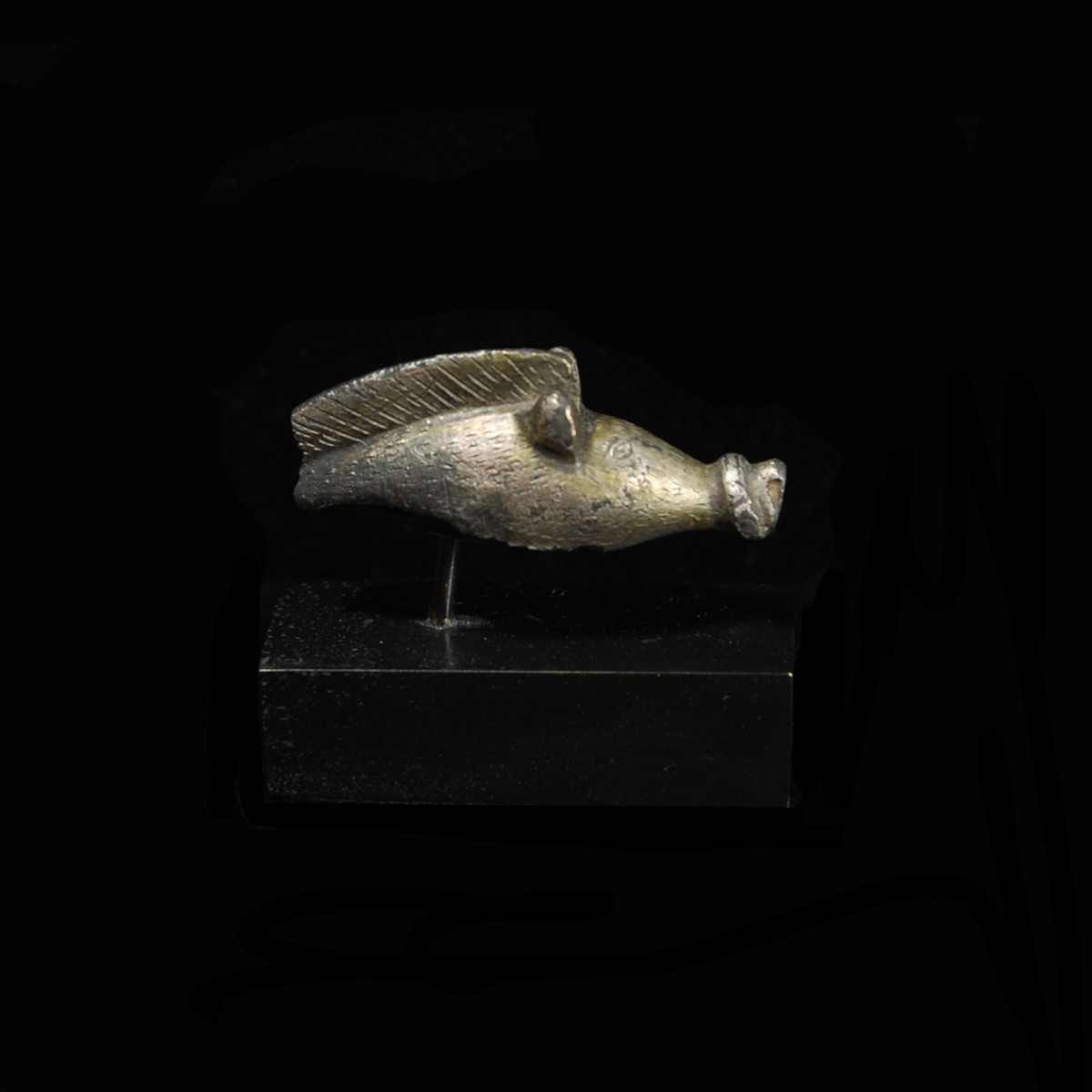
|
|
Middle Europe – 2nd-1st century B.C.
|
Very rare, stylized head of a silver boar. The snout long and cylindrical with a thick nose ring and punched nostrils. Eyes and fur finely engraved in cold work. The ridge elegantly pulled back, the ears in the front raised. The head once decorated a high-quality object. By all accounts found in Central Europe. Hogs were holy animals for the Celts, who believed that they originated from the “otherworld”. Therefore depictions of boars are found as funerary offerings, as crests, as standards and as decoration on torques. And not to forget: A hog brings fortune until today. Mounted.
|
Provenance: Found in the 1960s, since the 1970s in an English collection in Durham. Last in a collection in West Yorkshire.
Dimensions: 4 cm long
Price: 2 800 Euro
|
|
|
|
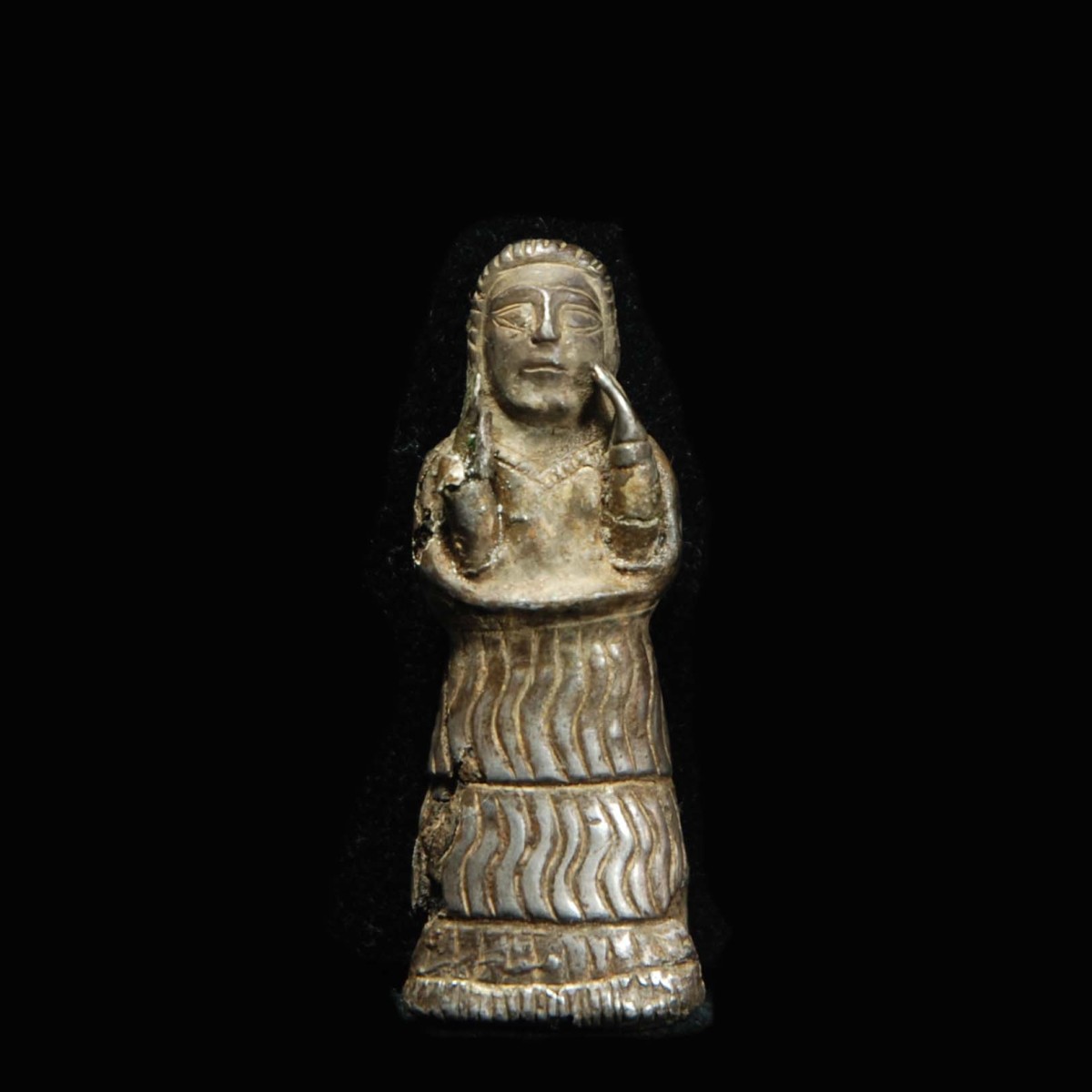
|
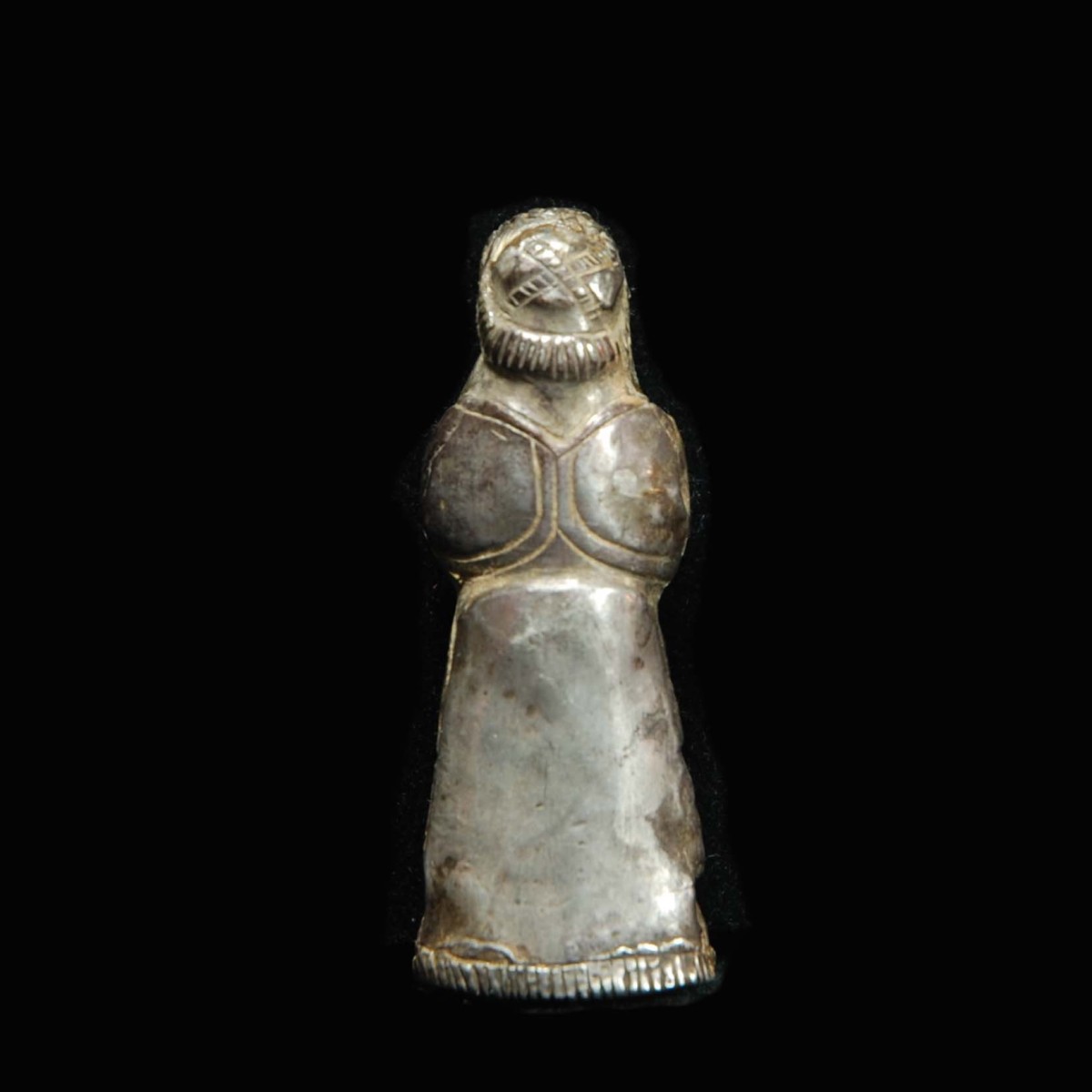
|
A silver sheet covering an organic material (bitumen?) forming a statuette of a female worshipper. The woman with a round fringe of hair and a segmented cap on the calotte wears a flounced dress with a wavy pattern which ends at the bottom with a hem. Over her breasts a v-neck. Her arms raised in an adoration gesture and the palms slightly curved facing each other. The eyes with pointy lids pulled outwards, the nose and brows prominent. See for the type with the same hand posture the bronze figure of a female worshipper from Susa, today in the Metropolitan Museum of Art with Accession Number 51.159. On the sides perforations indicating that the statuette possibly was once part of a sculptural group. Mounted.
|
Provenance: From an English private collection A.D., acquired on the English art market prior to 1990.
Dimensions: 4.7 cm high
Price: 3 800 Euro
|
|
|
|
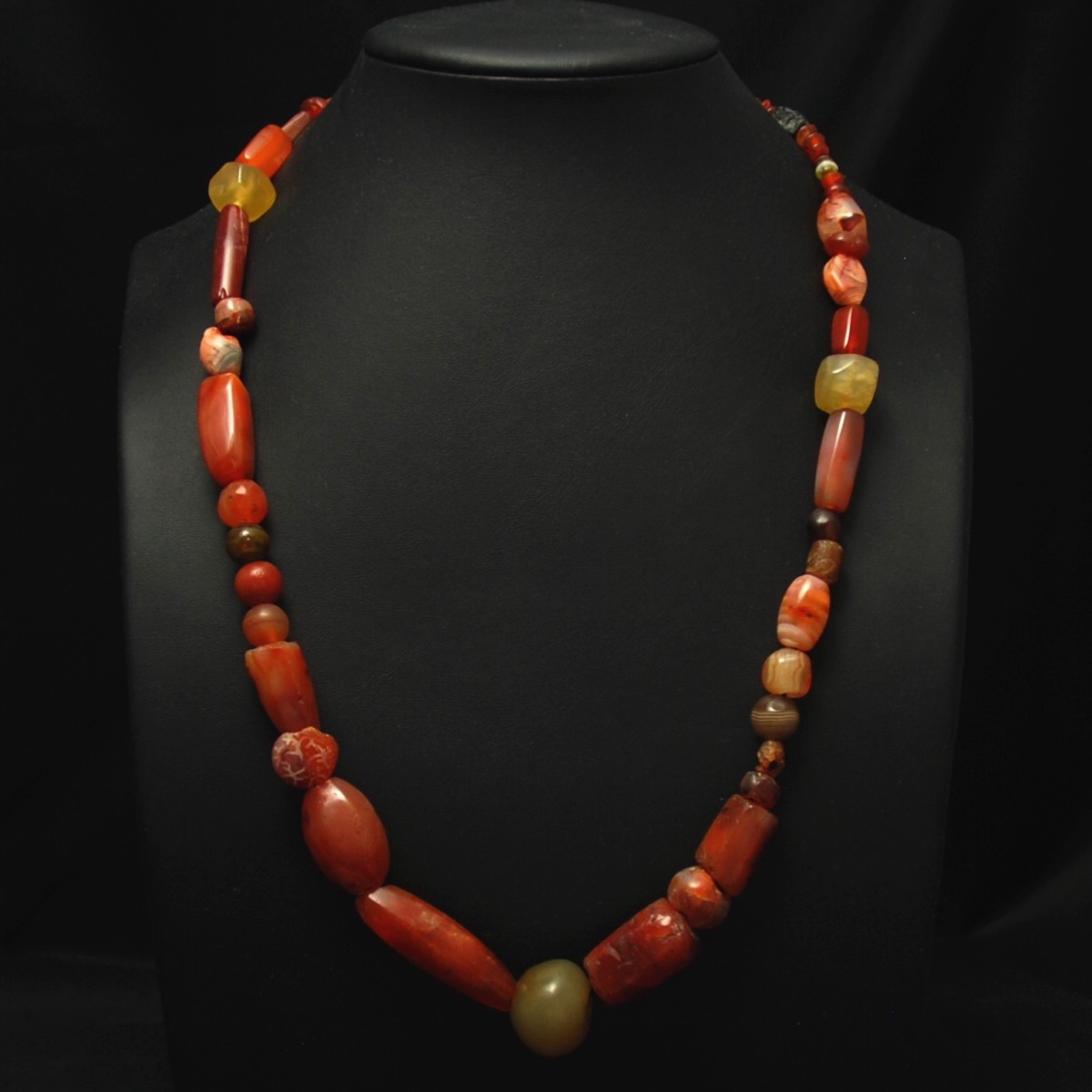
|
|
Levant – 1st millennium B.C.
|
Modern strung necklace of ancient stone beads, amongst them carnelian and agate. The beads are in different sizes and shapes, in the centre a large, ring-shaped agate bead. Ready to wear.
|
Provenance: Austrian private collection Heide Ramadan, acquried between 1970 and 1990.
Dimensions: 68 cm long
Price: 750 Euro
|
|
|
|
Five Neolithic Vinca Figures from the Jovanovic collection:
|
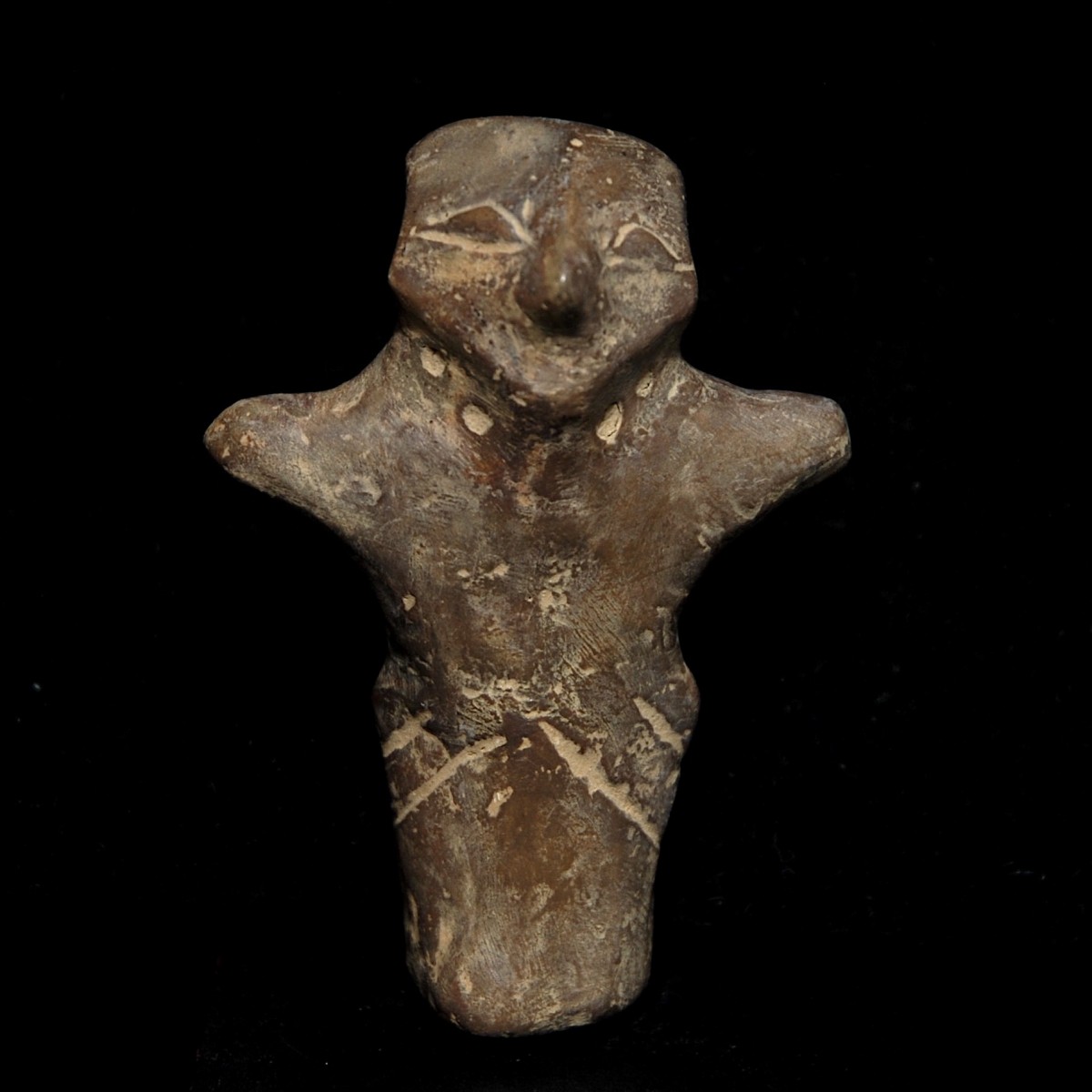
|
|
|
|
|
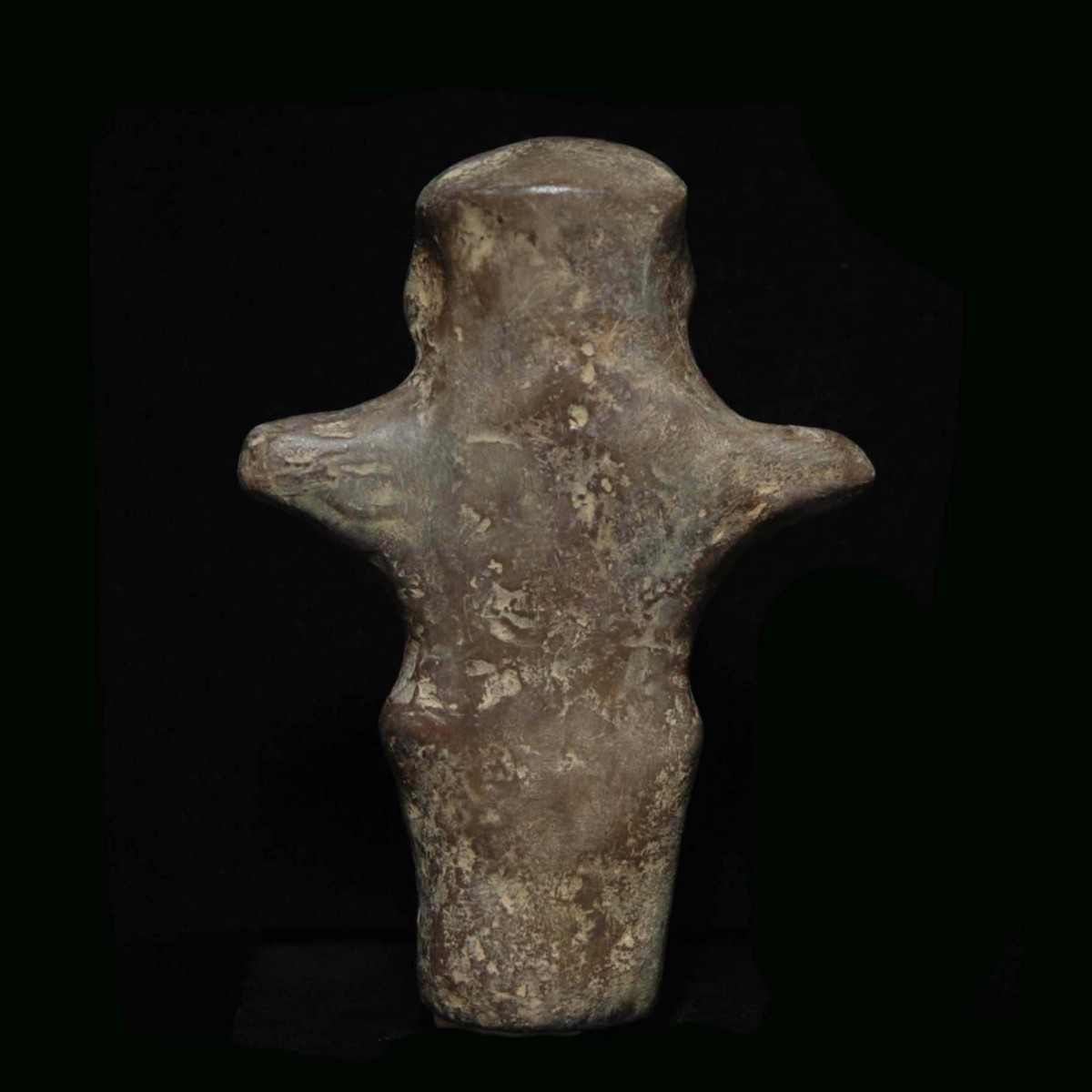
|
|
Southeastern Europe – 5500-4500 B.C.
|
Finely worked out, standing figure of the Vinča culture of light brown clay. The angular head with the typical mask-like face, semi-circular engraved eyes and a long, pointy nose. The back of the head is flat and merges into a calotte in a sharp edge. The figure wears a neck jewellery which is indicated by perforations. The stub arms protruding to the sides. The hips are protruding, the buttock is slightly rounded. The female figure wears a long dress, which is decorated by diagonal notches. The legs are not accentuated, the base is flat. Vinča figures such as the present one were used for cult purposes and served as fertility idols. From the area of Supska-Stublina.
|
Provenance: Viennese private collection Dusan Jovanovic (1956-2015), acquired 1970 from Galerie Erwin Richter in Wiener Neustadt, Austria. With a provenance confirmation by Erwin Richter. Since then in a family estate.
Dimensions: 7.5 cm high
Price: 4 800 Euro
|
|
|
|
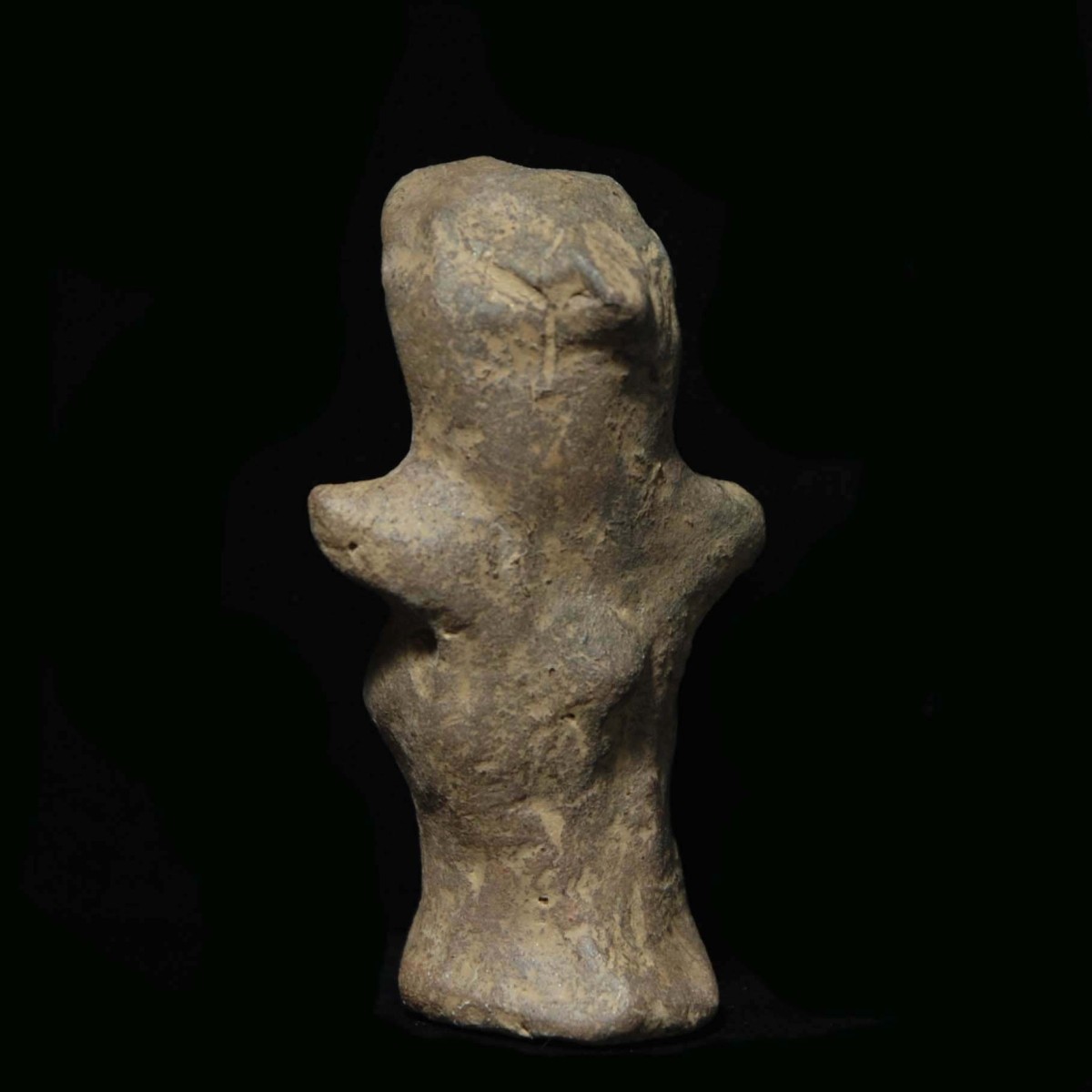
|
|
|
|
|
|
Southeastern Europe – 5500-4500 B.C.
|
Rare male figure of the Vinča culture of grey-brown clay. The angular head with a pointy, prominent nose. The back of the head pulled far back and tapering. The cylindrical figure is slightly bent forward and has stub arms on the sides. Approximately in the middle of the front the male private part is semicircularly formed. The buttock is far protruding. The legs are not accentuated and end in a broad, flat stand ring. Vinča figures such as the present one were used for cult purposes and served as fertility idols. From the area of Supska-Stublina.
|
Provenance: Viennese private collection Dusan Jovanovic (1956-2015), acquired 1970 from Galerie Erwin Richter in Wiener Neustadt, Austria. With a provenance confirmation from Erwin Richter. Since then in a family estate.
Dimensions: 8 cm high
Price: 3 600 Euro
|
|
|
|
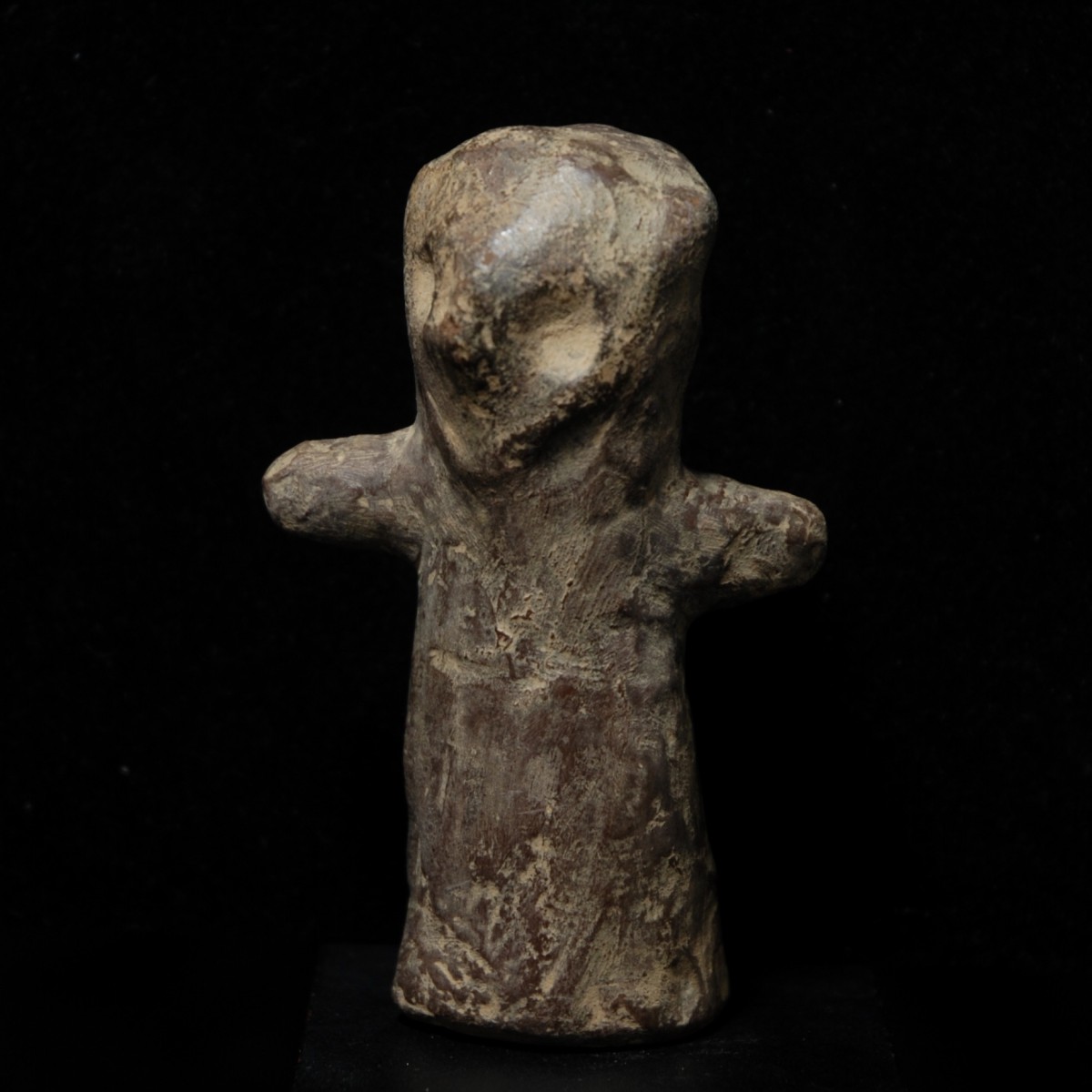
|
|
|
|
|
|
Southeastern Europe – 5500-4500 B.C.
|
Anthropomorphic figure of the Vinča culture of dark clay. The cylindrical statuette with a flat base, on the sides protruding, short arms and a large head with a flattened back. The triangular face with a broad, prominent nose and deeply pierced, round eyes. On the back the buttock is accentuated with dents. The rare depiction with exceptionally large eyes, possibly once with inlays, in the typical mask-like face. Vinča figures such as the present one were used for cult purposes and served as fertility idols. From the area of Supska-Stublina.
|
Provenance: Viennese private collection Dusan Jovanovic (1956-2015), acquired 1970 from Galerie Erwin Richter in Wiener Neustadt, Austria. With a provenance confirmation from Erwin Richter. Since then in a family estate.
Dimensions: 9.1 cm high
Price: 3 200 Euro
|
|
|
|
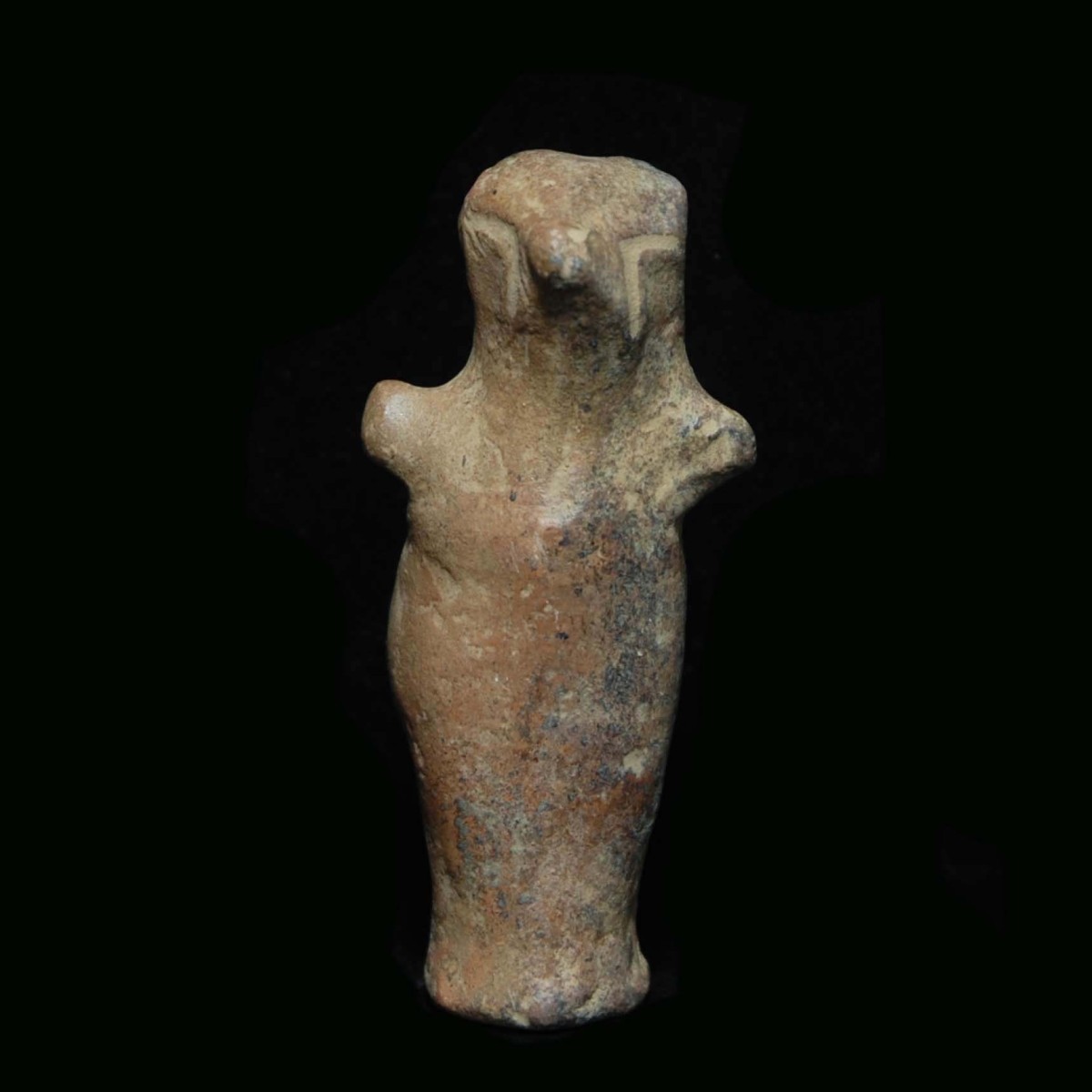
|
|
|
|
|
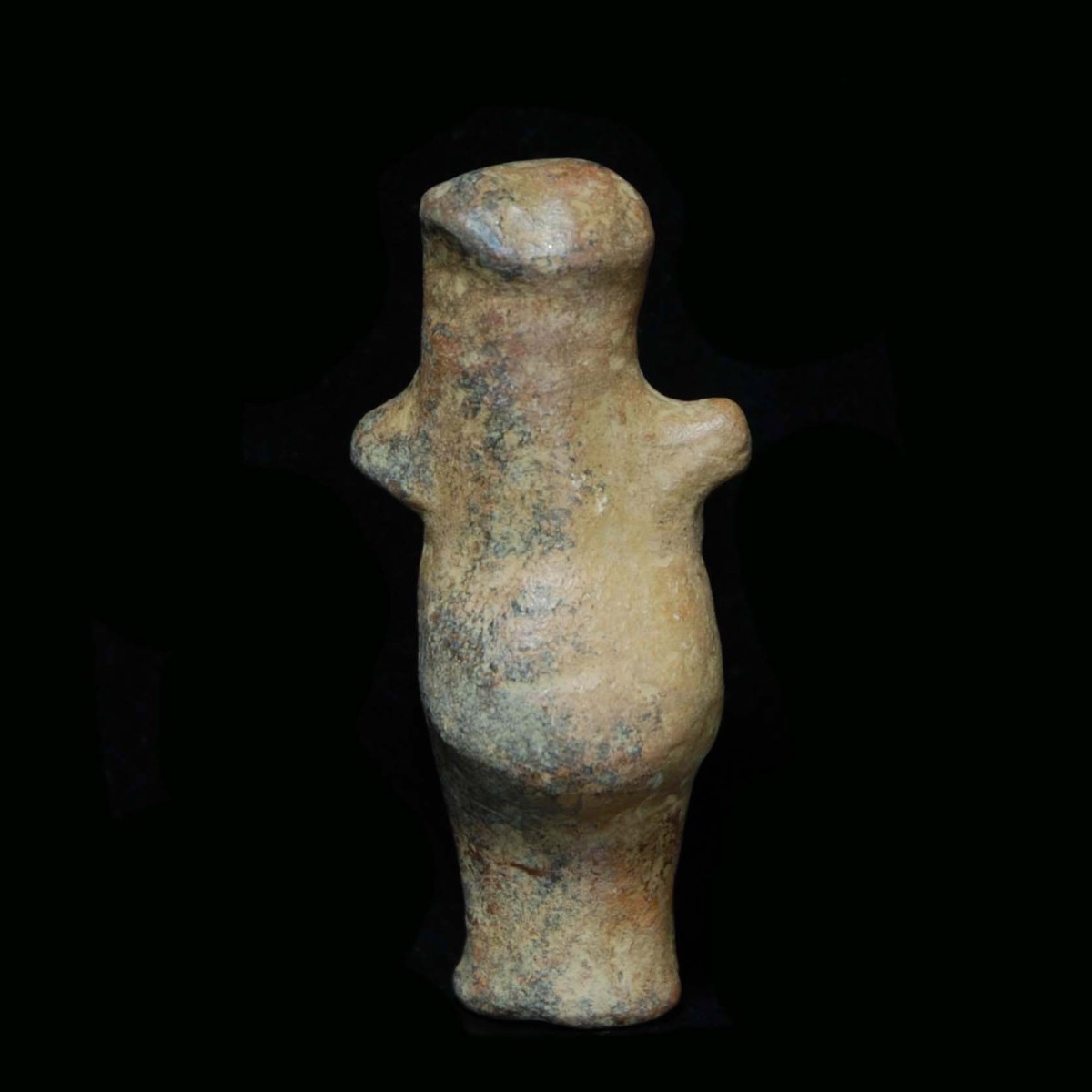
|
|
Southeastern Europe – 5500-4500 B.C.
|
Standing figure of the Vinča culture of light brown clay. The angular head with an overlong nose which lends the figure a zoomorphic look. The eyes are incised rectangularly, the back of the head slightly set off. The arms are protruding on the sides. Noticeable is the large, widely protruding and rounded buttock, representing the fertility cult, which the statuette was possibly used for. The legs are not accentuated and broaden towards the bottom to a round base. From the area of Supska-Stublina.
|
Provenance: Viennese private collection Dusan Jovanovic (1956-2015), acquired 1970 from Galerie Erwin Richter in Wiener Neustadt, Austria. With a provenance confirmation from Erwin Richter. Since then in a family estate.
Dimensions: 7.5 cm high
Price: 2 800 Euro
|
|
|
|
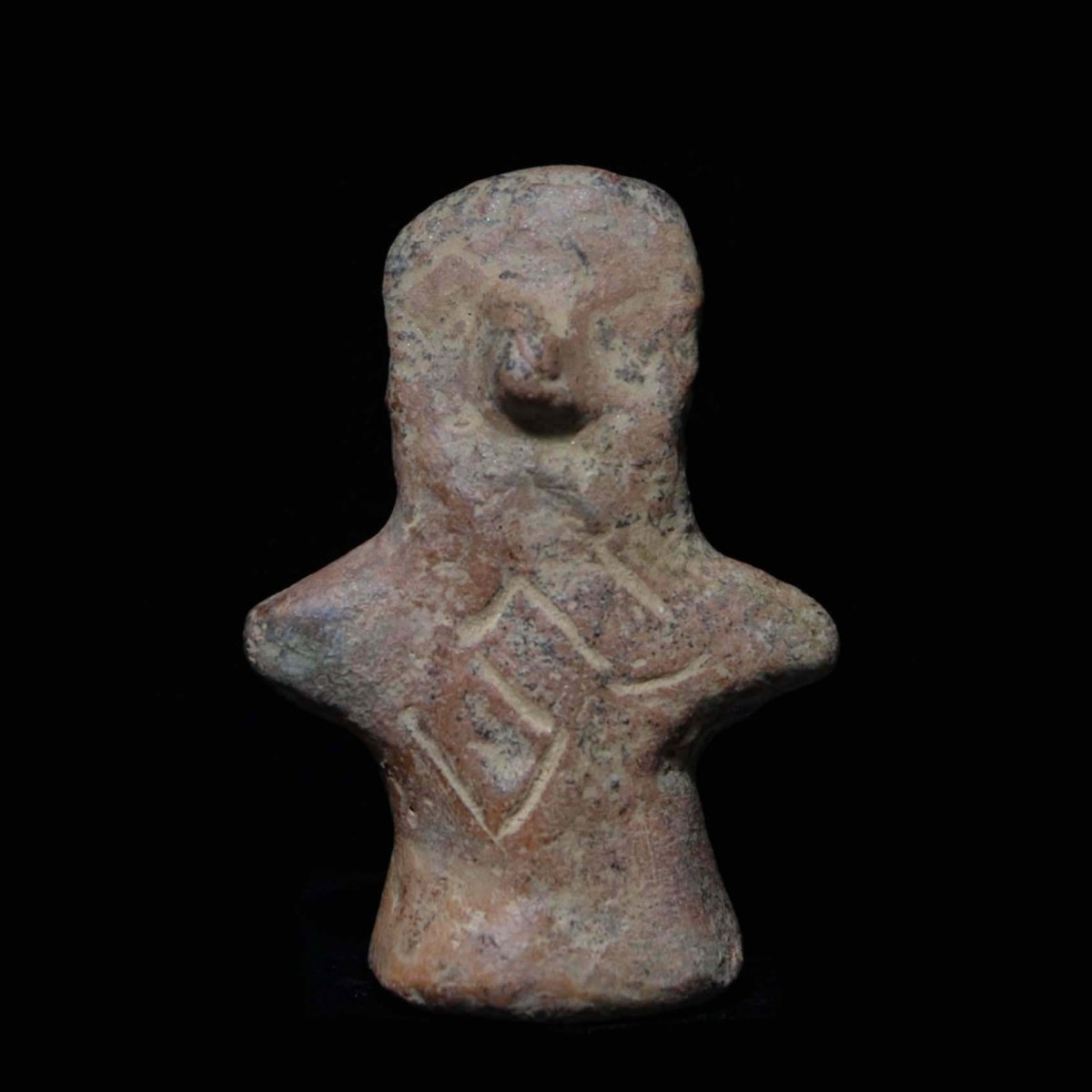
|
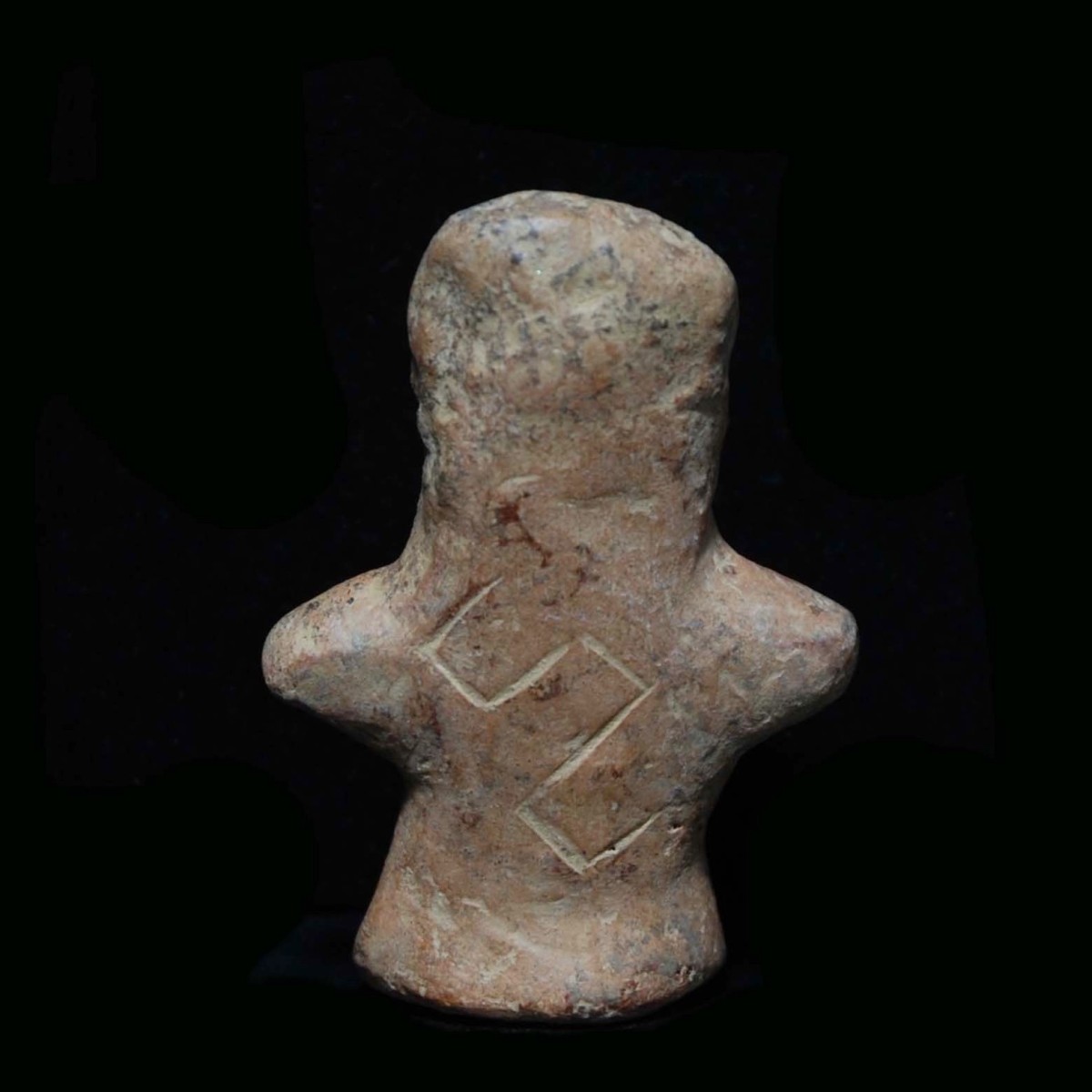
|
|
|
|
Southeastern Europe – 5500-4500 B.C.
|
Anthropomorphic figure of the Vinča culture of reddish-brown clay. The flat statuette stands on a rounded base. The angular head is oversized, has a prominent nose and slightly deepened, also angular eyes. The upper body in the front and in the back with rectangular incised decoration. The arms protruding and tapering outwards. The legs are not accentuated, the entire lower body is swaged. Vinča figures such as the present one were used for cult purposes and served as fertility idols. From the area of Supska-Stublina.
|
Provenance: Viennese private collection Dusan Jovanovic (1956-2015), acquired 1970 from Galerie Erwin Richter in Wiener Neustadt, Austria. With a provenance confirmation from Erwin Richter. Since then in a family estate.
Dimensions: 6.6 cm high
Price: 2 200 Euro
|
|
|
|
|
|
|
|
Frohe Festtage –
mit Jahrtausende alter Kunst
|
Haben Sie noch kein Weihnachtsgeschenk? Dann nutzen Sie jetzt die Gelegenheit und profitieren Sie bis Jahresende von der verringerten Mehrwertsteuer auf Kunst von 5 Prozent. Ab 1. Jänner 2022 wird die Mehrwertsteuer auf Kunst in Österreich wieder auf 13 Prozent angehoben. Die Wertsteigerung für antike Kostbarkeiten liegt aber nicht nur am Steuersatz. Die Auktionen der vergangenen Wochen haben gezeigt, dass die Nachfrage an Jahrtausende alten Meisterwerken größer ist als je zuvor. Ein Weltrekordpreis jagte den nächsten – auch bei Vinča-Figuren aus der mittlerweile weltberühmten Jovanovic-Sammlung, die zuletzt bei Christie's versteigert wurden. Wir betreuen die Jovanovic-Sammlung bereits seit einigen Jahren und nun ist es uns nun gelungen, die übrigen neolithischen Figuren aus dem Nachlass von Dusan Jovanovic (1956-2015) zu erwerben. In diesem Newsletter stellen wir die ersten fünf Vinča-Figuren vor.
|
|
|
|
Unser Highlight des Monats:
|
|
Ägypten – 26. Dynastie, 664-525 v. Chr.
|
Besonders fein gearbeitete und anmutige Sitzstatuette der Göttin Neith, der Haupt- und Schutzgöttin von Sais. Neith trägt die Krone von Unterägypten, die in Kaltarbeit fein verziert ist. Ihr eng anliegendes Kleid betont ihre großen, runden Brüste und die schmale Hüfte – eine Darstellung, die typisch für die 26. Dynastie ist. Sie hat ihre geballten Fäuste auf den Schoß gelegt, eine Faust aufgerichtet, die andere flach. Das rundliche Gesicht mit feinen Zügen, der Mund ist zu einem Lächeln geformt. Um den Hals trägt sie mehrreihigen Schmuck. Die Statuette sitzt auf einem antiken Holzsockel, der wohl zugehörig ist. Mit herrlicher rotbrauner Patina. Neith war die Göttin der Jagd und des Krieges. In der 26. Dynastie, der Saitenzeit, galt sie als oberste Schutzgöttin.
|
Provenienz: Erworben in den 1930er Jahren in Ägypten. Danach als Geschenk an eine englische Sammlerin. Durch Erbe an die Sammlung J. Pearson, England. Zuletzt im englischen und amerikanischen Kunsthandel.
Höhe: 16,6 cm
Price: 24.000 Euro
|
|
|
|
Ausgewählte Kunstwerke des Monats:
|
|
Mespotamien – 1785-1778 v. Chr.
|
Massiver Tonzylinder aus der Zeit des altbabylonischen Königs Sin-Iddinam von Larsa. Das „Keilschrift-Fass“ mit flacher Basis und kreisrunder Öffnung oben weist eine rund 70-zeilige Inschrift auf, die die gesamte Außenseite bedeckt. Sin-Iddinam betont darin, dass er für die Wasserversorgung seiner Stadt den Fluss Tigris ausbaggerte. Eine Reihe gleichartiger Zylinder sind bekannt und publiziert. Die Standard-Referenz stammt von Douglas Frayne „The Old Babylonian Period“, 1990, Seiten 158-160, E4.2.9.2. Übersetzung: „Ich, Sin-Iddinam, mächtiger Mann, Versorger von Ur, König von Larsa, König des Landes Sumer und Akkad, König, der den Ebabbar baute, den Tempel des Gottes Utu, der die Riten der Tempel der Götter wieder herstellte, als An, Enlil, Nanna und Utu mir eine gute, gerechte Herrschaft gewährten, deren Tage lang sind, durch meine große, überragende Weisheit, um gutes Wasser für meine Stadt, mein Land zu schaffen (und) meine Wege großartig zu machen, Lob (und) Tapferkeit für die Zukunft, ich betete zu den Göttern An und Enlil. Nachdem sie meiner Bitte zugestimmt hatten, beauftragten sie (mich) mit ihrem unabänderlichen Wort, den Tigris zu graben, (seine Ufer zu restaurieren) und meinen Namen für ein langes Leben zu etablieren. Damals, auf Anordnung der Götter An und Inanna, durch die höchste Macht der Götter Nanna und (Utu), habe ich dort durch meinen Erfolg den Tigris, den Fluss der Fülle des Gottes Utu, großartig gegraben. Nachdem ich den Flusslauf zurück zu meiner Grenze gebracht habe, der alten Grenze, richtete ich seinen Kurs direkt in einen Sumpf, (wodurch) er ewiges Wasser und ewige Fülle für Larsa, mein Land, lieferte. Als ich den Tigris, den großen Fluss, ausgrub, war der Lohn jedes Arbeiters: 1 Gur Gerste, 2 Sila Brot, 4 Sila Bier, 2 Schekel Öl, an einem Tag. Ich lasse niemanden weniger oder mehr nehmen. Auf Anordnung (und) Entscheidung der großen Götter habe ich (die Ufer) des Tigris, des breiten Flusses, wiederhergestellt (und) meinen Namen für die ferne Zukunft aufgestellt.“
|
Provenienz: Aus englischer Privatsammlung vor 1992, danach im englischen Kunsthandel.
Höhe: 14,5 cm
Preis: 12.000 Euro
|
|
|
|
|
Römisches Reich/Gallien – 2. Jahrhundert n. Chr.
|
Außerordentlich große und aus mehreren Teilen gearbeitete Bronze-Statue der Juno. Die Göttin und Gattin des Jupiters trägt ein langes bis zum Boden reichendes Kleid, das unter der Brust gegurtet ist. Sie hat einen Mantel über die Schultern geworfen, mit dem sie auch den Kopf bedeckt. Das Ende des Mantels fällt weit über die linke Schulter der Göttin herab. Der Umhang ist separat gegossen und mit einer Niete hinten an der eigentlichen Statue befestigt. Juno hat ihr dichtes Haar in der Mitte gescheitelt, das von einem dreistrahligen Diadem gehalten wird. Die Augen sind in Silber eingelegt. An den Füßen trägt sie Sandalen. Die Rückseite zeigt den Umhang in breiten Faltenwurf. Die ungewöhnlich große Statue ist aus mehreren Teilen gearbeitet. Neben dem Umhang waren auch die heute fehlenden Arme separat gegossen und montiert. Der etwa provinzielle Stil weist auf eine gallo-römische Arbeit hin.
|
Provenienz: Französische Privatsammlung. Versteigert im Dorotheum Wien am 28. April 1998, Los 45. Danach Privatsammlung Karl Zieger (1939-2021), Niederösterreich.
Höhe: 31,8 cm
Preis: 18.000 Euro
|
|
|
|
|
Griechenland – 3.-2. Jahrhundert v. Chr.
|
Anmutige hellenistische Terrakotta-Statuette eines Paares, das eng umschlungen auf einem Bett liegt. Der Mann liegt aufgestützt auf dem linken Ellenbogen und umarmt mit seinem rechten Arm die auf ihm liegende Frau. Die Frau schmiegt ihre Wange an die des Mannes, sie liegt auf dem Bauch. Die nach unten gerutschte Decke entblößt ihren Rücken und Teile des Gesäßes. Beide tragen Kopfbedeckungen über dem dichten, gelockten Haar. Das hohe Bett mit Kopflehne und kleinen Treppchen an der Seite. Mit schönen weißen, rosa und blauen Farbresten. Wohl aus Canosa. Mit alter Sammlungsnummer 10-85 an der Basis.
|
Provenienz: Aus der Privatsammlung des französischen Archäologen Louis-Gabriel Bellon (1819-1899). Seit über 120 Jahren in Familienbesitz.
Dimensionen: 10 cm x 11,2 cm
Preis: 6.000 Euro
|
|
|
|
|
Mitteleuropa – 2.-1. Jahrundert v. Chr.
|
Überaus seltener, stilisierter Kopf eines Ebers aus Silber. Die Schnauze lang und zylindrisch mit dickem Nasenring und gepunzten Nüstern. Augen und Fell fein in Kaltarbeit graviert. Der Rückenkamm elegant nach hinten gezogen, die Ohren vorne aufgestellt. Der Kopf zierte einst einen hochwertigen Gegenstand. Dem Vernehmen nach in Mitteleuropa gefunden. Schweine waren für die Kelten heilige Tiere, sie glaubten, dass diese aus der „Anderswelt“ stammten. Daher sind Darstellungen des Ebers als Grabbeigaben, als Helmzier, auf Feldzeichen und als Verzierung am Torques zu finden. Und nicht vergessen: Ein Schwein bringt bis heute Glück („Schwein gehabt“). Gesockelt.
|
Provenienz: Gefunden in den 1960er Jahren, seit den 1970er Jahren in einer englischen Sammlung in Durham. Zuletzt in einer Sammlung in West Yorkshire.
Länge: 4 cm
Preis: 2.800 Euro
|
|
|
|
Aus Silberblech über einem organischen Material (Bitumen?) geformte Statuette einer Adorantin. Die Frau mit rundem Haarkranz und segmentierter Kappe auf der Kalotte trägt ein Volantkleid mit wellenförmigem Muster und unten abschließendem Saum. Über der Brust ein V-Ausschnitt. Sie hat die Arme im Gebetsgestus angehoben und die Handflächen leicht gebogen einander zugewandt. Die Augen mit nach außen gezogenen, spitzen Lidern, die Nase und die Brauen markant. Vergleiche zum Typus mit derselben Handhaltung die Bronzefigur einer Adorantin aus Susa, heute im Metropolitan Museum of Art mit der Accession Number 51.159. Seitliche Lochungen weisen darauf hin, dass die Statuette wohl einst Teil einer Figurengruppe war. Gesockelt.
|
Provenienz: Aus englischer Privatsammlung A. D., erworben im englischen Kunsthandel vor 1990.
Höhe: 4,7 cm
Preis: 3.800 Euro
|
|
|
|
|
Levante – 1. Jahrtausend v. Chr.
|
Modern gefädelte Halskette aus antiken Steinperlen, darunter vor allem Karneol und Achat. Die Perlen selbst in unterschiedlicher Größe und Form, im Zentrum eine große, ringförmige Achatperle. Sofort tragbar.
|
Provenienz: Österreichische Privatsammlung Heide Ramadan, erworben zwischen 1970 und 1990.
Länge: 68 cm
Preis: 750 Euro
|
|
|
|
Fünf neolithische Vinca-Figuren aus der Sammlung Jovanovic:
|
|
Südosteuropa – 5500-4500 v. Chr.
|
Fein gearbeitete, stehende Figur der Vinča-Kultur aus hellbraunem Ton. Der eckige Kopf mit dem typisch maskenartigen Gesicht, halbkreisförmig gravierten Augen und einer langen, spitzen Nase. Der Hinterkopf ist flach und geht in einer scharfen Kante in die Kalotte über. Die Figur trägt Halsschmuck, der durch Lochungen angedeutet ist. Die Arme stehen stummelartig ab. Die Hüften sind seitlich ausladend, das Gesäß ist hinten leicht abgerundet. Die weibliche Figur trägt ein langes Kleid, das vorne durch Rillen dekoriert ist. Die Beine sind nicht akzentuiert, die Basis ist flach. Vinča-Figuren wie diese wurden für kultische Zwecke eingesetzt und dienten wohl als Fruchtbarkeitsidole. Aus der Gegend von Supska-Stublina.
|
Provenienz: Wiener Privatsammlung Dusan Jovanovic (1956-2015), erworben 1970 in der Galerie Erwin Richter in Wiener Neustadt. Mit Provenienzbestätigung von Erwin Richter. Seitdem in Familienbesitz.
Höhe: 7,5 cm
Preis: 4.800 Euro
|
|
|
|
|
Südosteuropa – 5500-4500 v. Chr.
|
Seltene männliche Figur der Vinča-Kultur aus gräulich braunem Ton. Der eckige Kopf mit spitzer, prägnanter Nase. Der Hinterkopf weit nach hinten gezogen und spitz zulaufend. Die zylinderförmige Figur ist leicht nach vorne gebeugt und hat seitlich abstehende Stummelarme. Etwa in der Mitte der Vorderseite ist das männliche Genital halbrund ausgeformt. Das Gesäß ist nach hinten weit ausladend. Die Beine sind nicht akzentuiert und laufen zu einem breiten, unten flachem Standring aus. Vinča-Figuren wie diese wurden für kultische Zwecke eingesetzt und dienten wohl als Fruchtbarkeitsidole. Aus der Gegend von Supska-Stublina.
|
Provenienz: Wiener Privatsammlung Dusan Jovanovic (1956-2015), erworben 1970 in der Galerie Erwin Richter in Wiener Neustadt. Mit Provenienzbestätigung von Erwin Richter. Seitdem in Familienbesitz.
Höhe: 8 cm
Preis: 3.600 Euro
|
|
|
|
|
Südosteuropa – 5500-4500 v. Chr.
|
Antropomorphe Figur der Vinča-Kultur aus dunklem Ton. Die zylinderförmige Statuette mit flacher Basis, seitlich abstehenden, kurzen Armen und einem großen, hinten abgeflachten Kopf. Das dreieckige Gesicht mit breiter, prägnanter Nase und tief gelochten, runden Augen. Auf der Rückseite ist das Gesäß beulenartig akzentuiert. Eine seltene Darstellung mit ungewöhnlich großen, möglicherweise einst eingelegten Augen im typisch maskenhaften Gesicht. Vinča-Figuren wie diese wurden für kultische Zwecke eingesetzt und dienten wohl als Fruchtbarkeitsidole. Aus der Gegend von Supska-Stublina.
|
Provenienz: Wiener Privatsammlung Dusan Jovanovic (1956-2015), erworben 1970 in der Galerie Erwin Richter in Wiener Neustadt. Mit Provenienzbestätigung von Erwin Richter. Seitdem in Familienbesitz.
Höhe: 9,1 cm
Preis: 3.200 Euro
|
|
|
|
|
Südosteuropa – 5500-4500 v. Chr.
|
Stehende Figur der Vinča-Kultur aus hellbraunem Ton. Der eckige Kopf mit überlanger Nase, die der Figur ein zoomorphes Aussehen verleiht. Die Augen sind rechtwinkelig eingeritzt, der Hinterkopf leicht abgesetzt. Die Arme stehen stummelartig ab. Auffällig ist das große, weit ausladende und abgerundete Gesäß, das für den Fruchtbarkeitskult steht, in dem die Statuette wohl Verwendung fand. Die Beine sind nicht akzentuiert und laufen unten, etwas breiter werdend in einer runden Standfläche aus. Aus der Gegend von Supska-Stublina.
|
Provenienz: Wiener Privatsammlung Dusan Jovanovic (1956-2015), erworben 1970 in der Galerie Erwin Richter in Wiener Neustadt. Mit Provenienzbestätigung von Erwin Richter. Seitdem in Familienbesitz.
Höhe: 7,5 cm
Preis: 2.800 Euro
|
|
|
|
|
Südosteuropa – 5500-4500 v. Chr.
|
Antropomorphe Figur der Vinča-Kultur aus rötlich braunem Ton. Die flache Statuette steht auf einer abgerundeten Standfläche. Der eckige Kopf ist übergroß, hat eine prägnante Nase und leicht vertiefte, ebenfalls eckige Augen. Der Oberkörper vorne und hinten mit rechtwinkeligem Ritzdekor. Die Arme stehen seitlich ab und verjüngen sich nach außen hin. Die Beine sind nicht akzentuiert, der gesamte Unterkörper ist gestaucht. Vinča-Figuren wie diese wurden für kultische Zwecke eingesetzt und dienten wohl als Fruchtbarkeitsidole. Aus der Gegend von Supska-Stublina.
|
Provenienz: Wiener Privatsammlung Dusan Jovanovic (1956-2015), erworben 1970 in der Galerie Erwin Richter in Wiener Neustadt. Mit Provenienzbestätigung von Erwin Richter. Seitdem in Familienbesitz.
Höhe: 6,6 cm
Preis: 2.200 Euro
|
|
|
|
|
|
|
CHRISTOPH BACHER ARCHÄOLOGIE ANCIENT ART GmbH
|
Galerie: Stubenring 20, A-1010 Wien
Showroom: Untere Viaduktgasse 55, A-1030 Wien
|
|
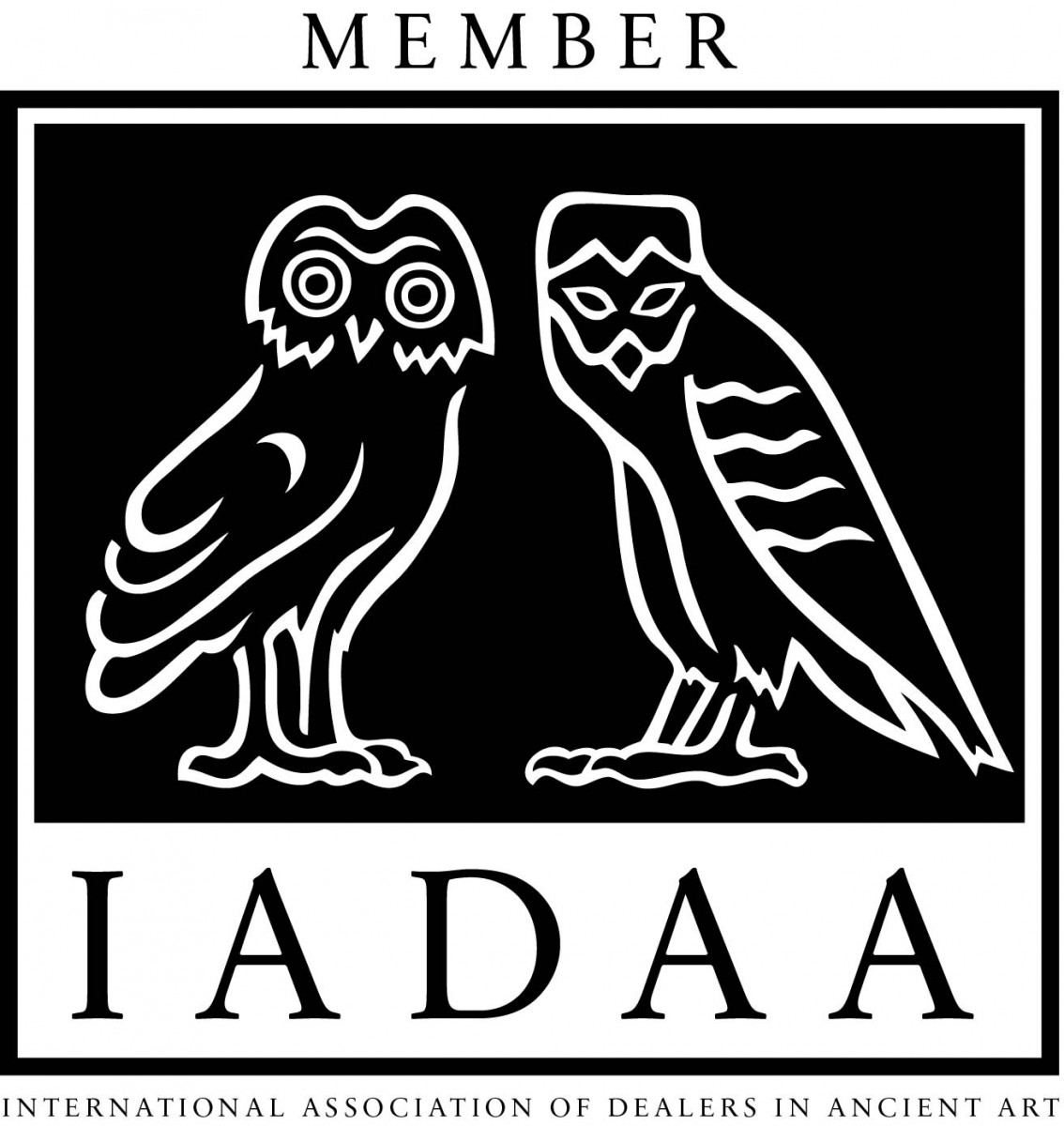
|
|
|
|